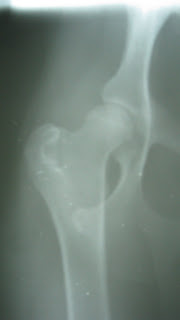
Sunday, March 29, 2009
Is this a good hip???
Yikes!! If you didn't know the history on this little pup you would think he must have had some form of trauma and dislocated his hip. Unfortunately, both of his hips look like this, they are both dysplastic. He is a small breed dog about 10-12 pounds and around one year of age. He presented for dislocating knee caps (patellar luxation) and in the preliminary xrays for knee surgery we always evaluate the hip/knee alignment. Good thing, because we had no idea this little guy had "floating" hips. If he develops pain as he gets older, he is too small for a conventional total hip joint replacement and he will get an FHO (Femoral Head and Neck Ostectomy) to alleviate any discomfort. This owner is potentially anticipating 4 orthopedic surgeries in this little guy, both hips and both knees. What an investment! It is always sad to give owners this type of news and shows us that good breeding is best for the pet and the owner.

Tuesday, March 17, 2009
Good Hip, Bad Hip


Can you tell the difference between these two hip radiographs? Hip Dysplasia is a devastating disease for many dogs. Hips can be degenerative as early as age 1 to 2 years of age. The way to evaluate for this disease is done by taking survey radiographs (x-rays) in a specific position. Breeding dogs should be screened for this disease prior to breeding, if either potential parent is dysplastic they should not be bred, no exceptions. However, occasionally two normal adult dogs may still have puppies with dysplasia, but it is much less likely. Dogs that are diagnosed with Hip Dysplasia have options for surgery or medical treatment. If the problem is detected prior to 8-10 months of age a surgery called a TPO (Triple Pelvic Osteotomy) can be performed to improve the joint conformation so that arthritis does not set in. If the dog is over 10-12 months, or if degeneration is already present they may be managed medically for a while and tend to do better if not overweight. Later they may be a candidate for a THR (Total Hip Replacement). The cost of these surgeries are ranging from $1,800.00 to $4,500.00. If left untreated the hip typically begins to separate from the joint socket and causes pain, stiffness and the inability to get up from a sitting or laying position. Late in the disease we occasionally see dogs that cannot even get up anymore or when walking their hips dislocate and they fall. Eventually there may be a genetic marker for this disease which would help us try to eliminate dysplasia and other genetic diseases from the dog population with a blood test. High risk breeds are large and giant breed dogs. (St. Bernards, Great Danes, Mastiff, Labradors etc...) OFA (Orthopedic Foundation for Animals) is an organization that screens and certifies hips, elbows, eyes, cardiac disease and other specific genetic conditions in many breeds. You can visit their website for more information at www.offa.org
Sunday, March 8, 2009
March is Spay / Neuter Month!

Please do your part to control the pet population. By spaying and neutering your pet you are also preventing multiple health issues later in their life. Uterine infection, reproductive cancers, prostate issues and other types of cancers are eliminated from their future. Also an altered pet is more likely to have less behavioral issues if done early in life.
Subscribe to:
Comments (Atom)